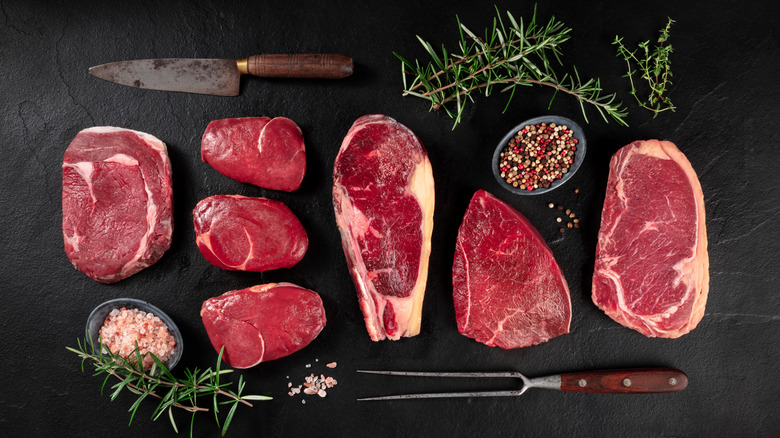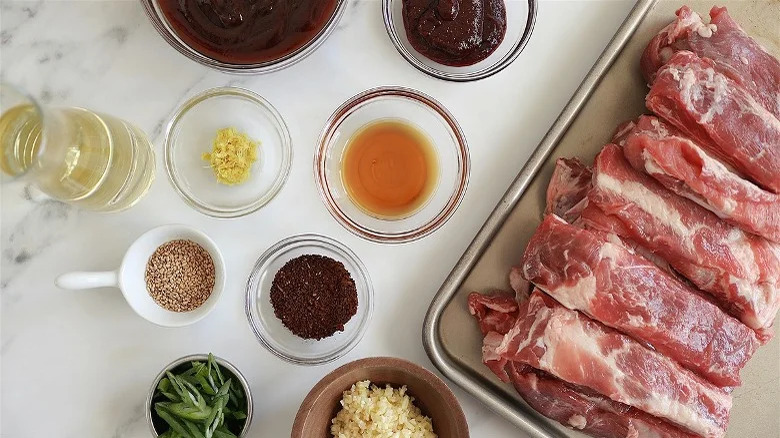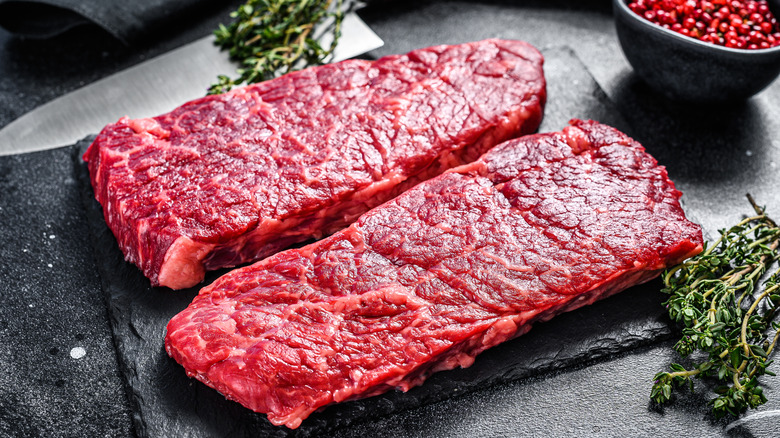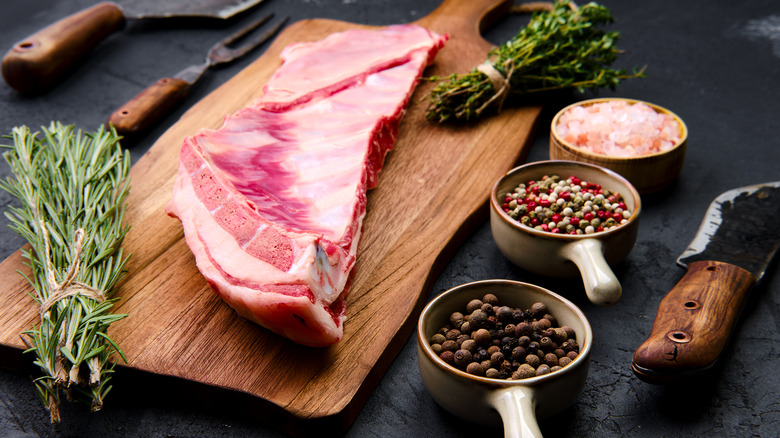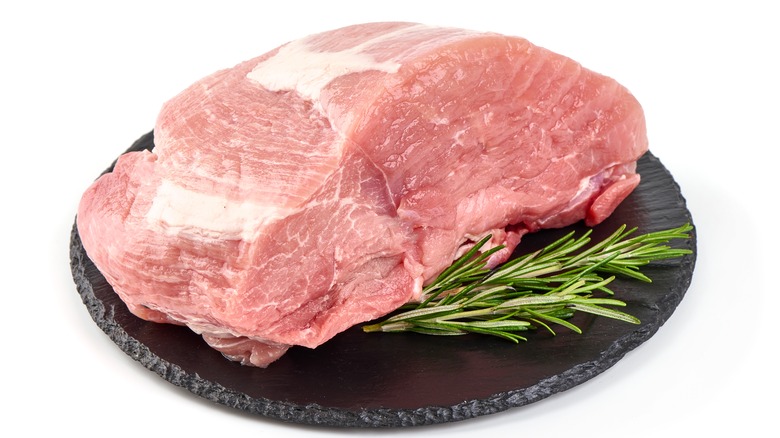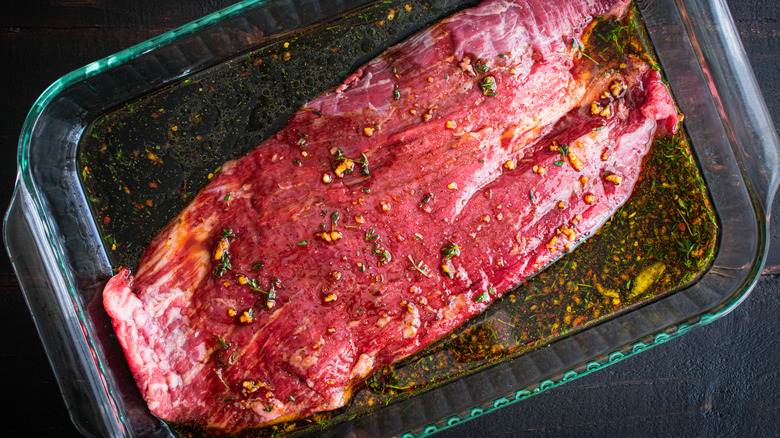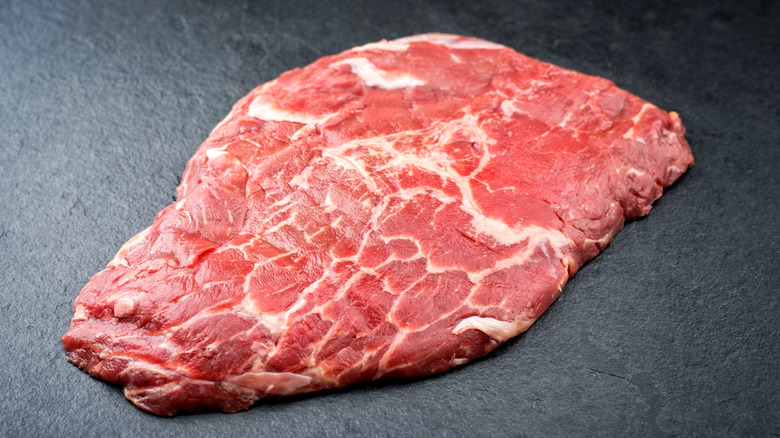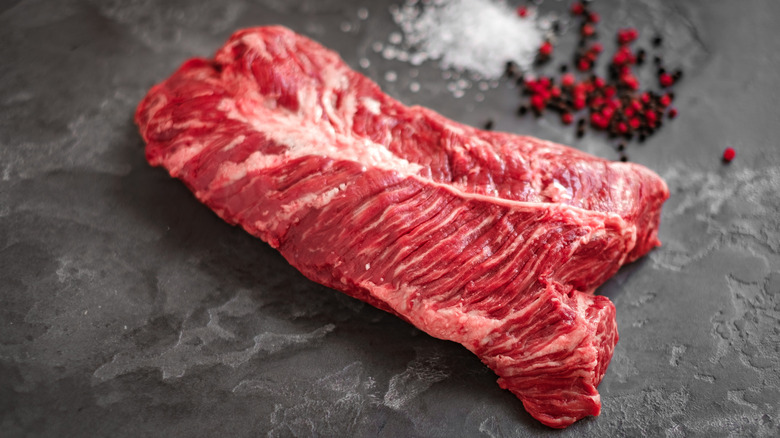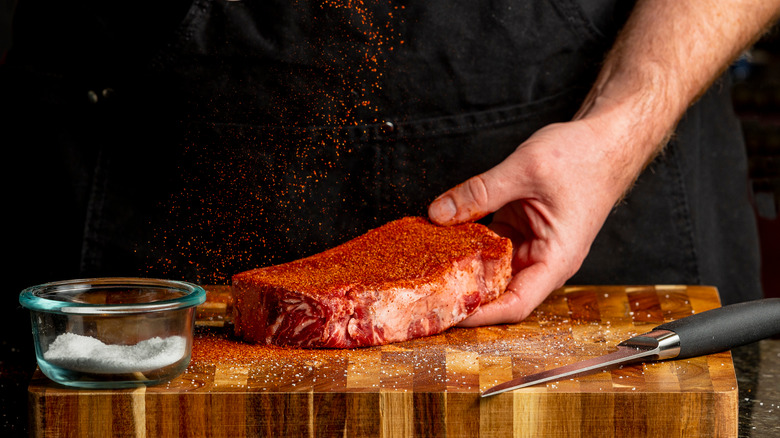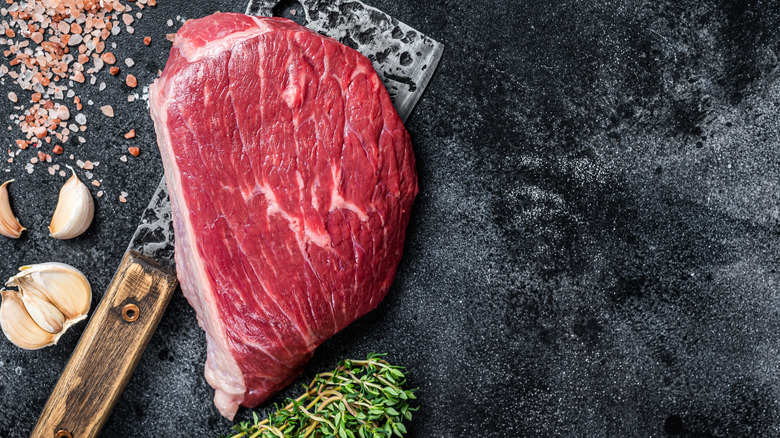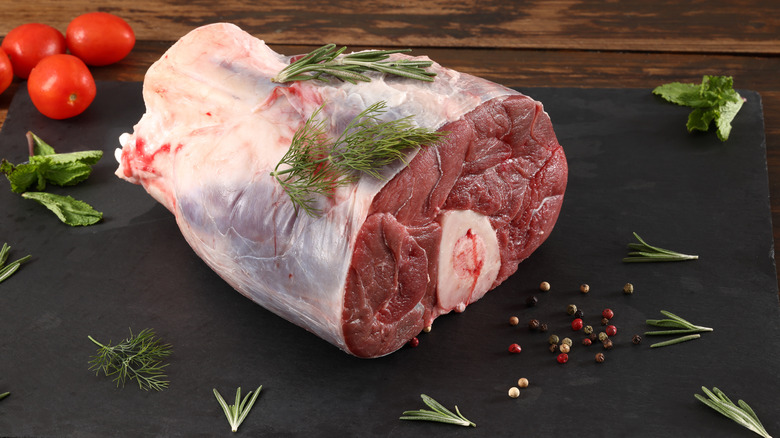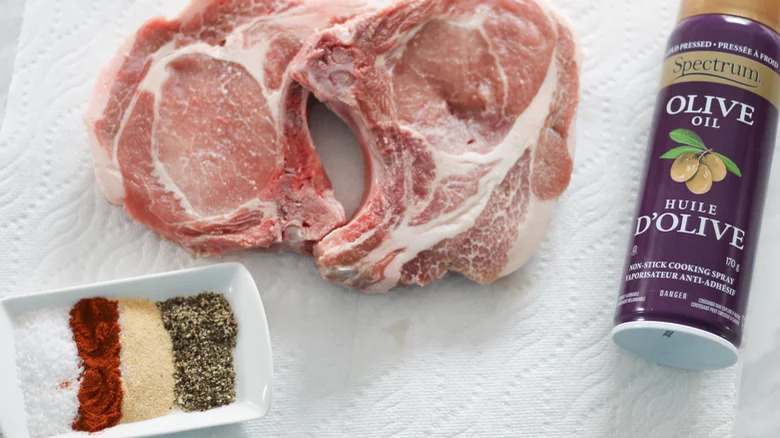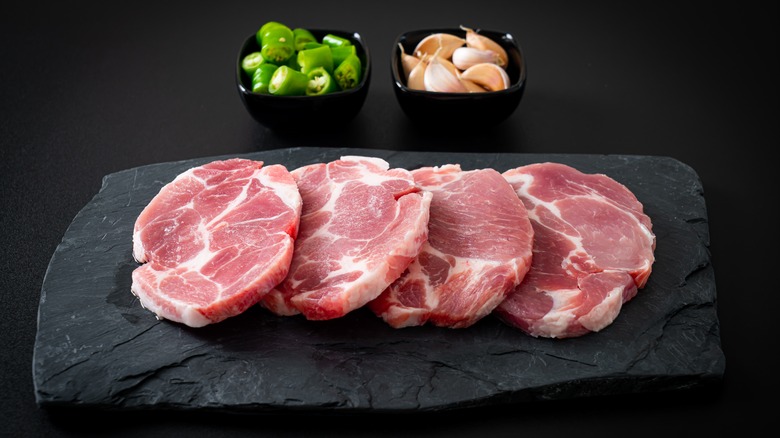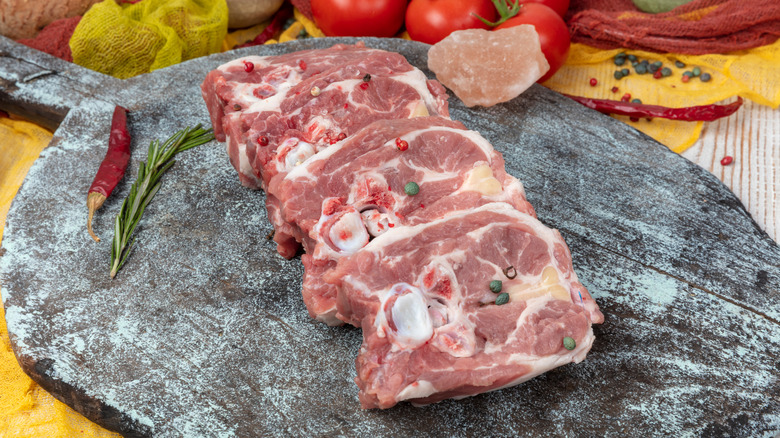13 Affordable Cuts Of Meat You Shouldn't Overlook
With food prices surging and a generally unstable supply of meat affecting production across the globe, the types of cuts traditionally considered top-tier, including rib eye and filet mignon, are now more expensive than ever. Fortunately, there are affordable cuts of meat out there ... if you are willing to have a little more patience in your cooking by using marinades, braising, and generally low and slow methods. Experimenting with less expensive cuts of meat instead of the popular pricy ones opens your meals to wildly underrated tastes.
Some slices, like the merlot and hanger steak, may require a trip to your local butcher shop instead of your closest chain supermarket. However, this will also give you a great opportunity to learn more about the huge variety of meats available outside your usual grocery aisles. Doing so gives you an edge over fellow cooks in the U.S., as research by the American Meat Institute shows that only 5% of people in the country buy their food primarily from butcher shops.
Whether you prefer the flavor of beef, pork, or lamb, you can find an economical cut of meat to make into a hearty, elevated homemade dish. Plenty of cuts of meat won't eat too much into your wallet; you just need to know how to best cook them to bring out their flavor.
Pork spare ribs
Not all ribs are made equal. In fact, one of the juiciest and tastiest parts of pork ribs also happens to be one of the least expensive: pork spare ribs. Compared to baby back ribs, pork spare ribs are flatter and larger slabs of meat, with about 11 bones and some nicely marbled meat between them. This cut of meat is located closer to the belly, which means it contains a higher percentage of fat and a fair amount of flavor.
For those who like to bite the meat right off the bone, the downside compared to baby back ribs is that most of the meat on the spare ribs is located between the ribs and not so much on the bone itself. You can cook pork spare ribs in several ways, but one preferred method is grilling them. The ribs are great to serve at barbecue get-togethers, as long as you cook them on low heat for a long time to break down the tough, fatty parts of the meat and make the cut more tender.
Chuck steak (Denver cut)
If you love ribeye, your wallet will love the chuck steak even more. Chuck comes from the part of the cow between the neck and ribs. As the cow is a herd animal, it's one of the muscles that works the hardest and, therefore, tends to be a bit on the tough side. This makes it less expensive than the softer filet mignon cut, for example.
However, if you know how to cook the chuck steak and which particular cut to buy, it's actually packed full of flavor. Always ask for the Denver cut, part of the chuck located right behind the shoulder blade. It's a particularly lean, flavorful cut with great marbling that isn't as exercised as other parts of the chuck.
To tenderize the meat, the best way to make it is in sous vide style. Slow, long cooking methods, in general, will help break down the sinewy parts of the meat and bring out the essential flavor of this cut.
Lamb breast
Lamb chops may be one of the most popular cuts of meat, but did you know that lamb breast can also be used to make a delicious meal? This cut of meat is named misleadingly: the lamb breast actually comes from the belly of the lamb.
Even if you don't like fat, don't let the fat cap of this cut intimidate you. Most of it comes off in the cooking process and helps to infuse taste into the meat before it drops off. To preserve all the possible flavor, make sure to cook the lamb by roasting, smoking, or braising it with the bone in; you will generally know it's done when the meat comes right off the bone. The resulting lamb should be crispy on the outside, tender on the inside, and surprisingly juicy and tasty.
As a bonus tip, if you cure a lamb breast instead, you can make a great (and halal-friendly) lamb bacon.
Pork shoulder
One of the most inexpensive cuts of pork on the market, pork shoulder, is relatively cheap because it is one of the toughest parts of the pig. However, if you throw the shoulder on your barbecue for some time, you can make pulled pork as the greats do. Use that pulled pork in a sandwich, burger, or on its own accompanied by some classic Southern-inspired sides. Alternatively, pork shoulder is used as the meat in recipes for tacos al pastor, although traditionally, it's cooked on a spit, like shwarma.
Pork shoulder comes lower on the pig than the slightly better-known (and pricier) pork butt, which is higher on the pig's foreleg. Both cuts are quite flavorful and inexpensive, though higher cuts can be turned into pork steaks, as at the renowned Snow's BBQ.
If you want the best part of the pork shoulder to use, ask for the not-so-eloquently named Boston butt. Different from the standard pork shoulder, it comes from the upper part of a pig's shoulder, located right behind the neck. It also includes a blade bone for added moisture, which barbecue legends like Rodney Scott and Aaron Franklin are known to prefer.
Merlot steak
Sourced from the heel muscle of the cow, merlot steak is somewhat more tender than the tougher flank steak, though it also has very little fat. These thin, flat cuts are great for grilling or pan-searing. You can either marinate them in advance or use a dry rub to infuse the cuts of meat with flavor.
Unfortunately, merlot is also a cut you probably won't find in your local supermarket, so search for a good butcher shop in town. It's more than worth it, as this steak delivers a lot of flavor for a relatively low price.
The key to keeping the merlot cut tender for serving is how you slice it. The merlot is partly more tender than a flank steak because of its relatively finer grain. In order to cut the steak accurately, look for the grain, then rotate the steak a little bit so you can slice against it. Make sure to cut the steak only after it has been seared or grilled and left to rest for at least five to 10 minutes.
You can combine a variety of sauces and butter with merlot steak, including diverse arrays of compound butter that will add another dimension to the meat's flavor. It's a thin piece that works most regularly as a recipe addition rather than a centerpiece for steak and potatoes.
Teres major
If you are having trouble finding a teres major cut, know that it can also be sold under other names, including petite tender, shoulder tender, or mock tender. Since this cut doesn't have the sinewy, tough fibers of other cuts, you can keep the preparation simple. Grill it, pair it with a delicious steak sauce like a bearnaise or peppercorn, and allow the inherent deliciousness of the meat to shine through.
Taken from the cow's shoulder and related to the much more expensive filet mignon and beef tenderloin, the teres major beef cut is a very tender bit of meat that can be bought at a much more affordable price than most. In fact, it's the second most tender beef cut you can buy. The reason the teres major hasn't been as popular as something like the filet mignon is that it is a tricky part of the cow to extract, so only skilled butchers regularly attempt to do the unconventional maneuver. Still, it has been quietly popping up in both restaurants and butcher shops around the U.S. lately, so you are likely to come across it more often.
Onglet (hanger steak)
Though it is gradually getting more expensive thanks to its increasing popularity, going from a butcher's secret to increasingly popular items on restaurant menus, the hanger steak still gives a great bang for your buck. Since only about two hanger steaks can be taken from each cow, a generally limited supply might make the hanger a little more rare to find.
The hanger steak comes from the belly of the cow, cut near the front. It is a relatively tender cut since the belly doesn't bear much weight or get abundant exercise while the cow is alive. You may also have heard of it referred to as a butcher's steak, hanging tender, or onglet. If you have a great new marinade or dry rub, you want to try out on your next steak, the hanger steak is a great (and economical) choice to experiment with for your next meal.
This cut's soft, tender texture helps soak up any marinade flavor. Cook this steak somewhere between medium rare and medium well, as anything too rare or too well done will make consuming it a bit challenging.
New York strip steak
A staple in everything from diners to steakhouses across the country, the New York Strip steak, also known simply as a strip steak, isn't exactly cheap, but it is more affordable than the gourmet rib eye and filet mignon cuts. This is partly thanks to the fact that it's a little leaner than the rib eye and a little chewier than the filet mignon.
You can still derive a lot of flavor from the fat surrounding the cut, especially if you cook the meat slowly. Searing it also develops a caramelized flavor. Most people trim the fat off or at least trim it down; it's a good idea to leave just a little section to impart flavor to your steak during cooking. To make something different, try making a New York strip roast instead of the classic grilled steak.
Bonus tip: Since the New York strip has become somewhat more expensive over the years, you can make it an even more economical choice by purchasing a whole striploin, the part of the cow from which the strip steak derives. Do a little butchering work to cut it down to several strip steaks — most striploin will cede around a dozen, give or take — and you will be able to have more than a few budget-friendly but fancy-feeling home dinners.
Sirloin cap
The sirloin cap is immediately visually identifiable to most because of a relatively thick band of fat that lines it. This fat band may not look appealing to some, but it gives the sirloin cap its extra juicy flavor.
It's possible you already know this cut of steak and don't realize it, as it is quite popular in Brazilian cuisine under a different name. You can usually find it on menus listed as either a picanha or a culotte steak. Though you can grill or roast this cut of meat, as with most other steaks, if you have the time and a rotisserie, try to make it in the classic Brazilian churrascaria style instead.
Cut deep into the surface of the fat cap without cutting into the meat itself. This will render out the fat when you start cooking your sirloin cap, making sure it imparts the fat's flavor onto the meat without leaving those big, chewy, fat parts on the meat itself. Sprinkle some sea salt over the meat. The cap doesn't need a lot of heavy seasonings as it naturally has quite a strong flavor. Then, skewer each steak and cook it on the rotisserie over a charcoal fire. When it's done, you're ready to serve.
Beef shank
Butchers take the shank from the cow's forearm. This placement results in a lean, sinewy cut of meat. Like most tougher cuts, the key to making it flavorful and easy to cut and eat is to cook it on low heat for a long period of time, as in braising. The low, moist heat breaks down the tendons and sinews of the cut, resulting in a juicy and tender meat dish. This process is used to make the famous Italian dish, osso bucco.
The beef shank is an alternative to the pricier short rib, but it can't be found in most grocery stores. This is due in part to its relative toughness. However, it is still very useful and flavorful in braised form or for making ground beef. In addition, the bone of the beef shank contains a lot of marrow, which has proteins, fat, gelatin, and a lot of other components that hold a whole lot of flavor. You can cook the bone over a long period of time to release these flavors and make a delicious bone broth.
Pork chops
Pork chops are found everywhere, from restaurants to home refrigerators, and are beloved for their versatility, as they can be cooked almost any way. They are common cuts that derive from pork loin, between the hips and shoulder but under the back. Simply rub them with some spices beforehand, or marinade the chops overnight before preparing them in your preferred style.
People prefer pork chops because they are lean, unprocessed cuts of the pig taken from the area around the spine and ribs. Though pork chops can be made relatively fast in an air fryer or a pan, the meat is susceptible to drying out if not cooked right. For this reason, if you have the time, a slower cooking method like a quick pan sear followed by braising the chops over time will retain the juiciness of this meat cut without compromising the flavor.
Another alternative is to brine the pork chop for an hour or two before cooking it. Using a salt brine will help preserve moistness. Similarly, you can opt for bone-in chops. Bones release moisture naturally as they cook, giving your chops a failsafe against becoming parched.
Pork collar (coppa)
You have probably eaten pork collar if you've had Italian salami, as this cut of meat, also known as coppa, is usually cured to make the famous Italian cold cut. However, you can also use it in your cooking as an alternative to the much pricier pork loin. In fact, pork collar is nicknamed "the money muscle" as many grillers consider it the best possible cut from the pig, thanks in part to its extensive marbling.
The collar comes from a section of the pig's neck and upper back. This tender piece of pork can be cooked in a variety of ways, though grilling or smoking is usually preferred. When you cook the coppa, make sure you keep the small layer of fat attached during the process, which will help preserve both the meat's juice and taste.
If you're having trouble finding it in your local supermarket or butcher shop, try looking for it under one of its alternative names like collar butt or neck fillet.
Lamb neck
Since this cut of meat comes from the neck of the lamb, it has a fair amount of connective tissue that makes the meat relatively tough. Lamb neck is another one of those cuts that's worth a little extra time and effort to truly coax the flavor out of it and tenderize the meat.
You can find lamb neck boneless or with the bone still intact. Either cut will work for a braised lamb meal, but a lamb neck with the bone in will result in extra flavor thanks to its bone marrow. Plus, if you cook it correctly, for example, by braising it in red wine over the space of a couple of hours, the meat will eventually fall right off the bone. Cooks can also use this cut in a delicious stew, perfect for a winter meal.
This cut is cheaper than the usually preferred lamb shoulder because of the toughness of the meat's tissue; but cook it right and you will end up with a hearty meal and more savings.
